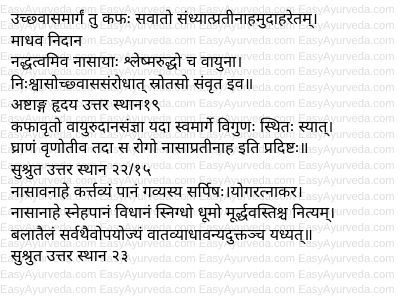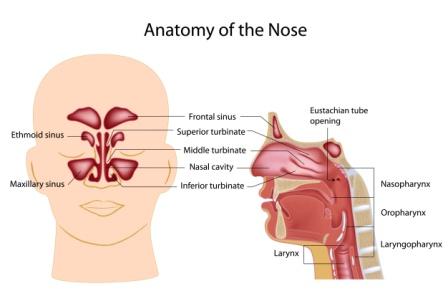Nasanaha: Meaning, Symptoms, Treatment, Modern Correlation
By Dr Raghuram Y.S. MD (Ay) & Dr Manasa, B.A.M.S
Nasanaha is a condition wherein there is obstruction in the nasal cavity. This will cause difficulty in breathing through the nose. It is also called as Nasa Pratinaha. Nasa = nose / nasal cavity, Anaha = obstruction.

Read – Pinasa – Meaning, Symptoms, Treatment
Table of Contents
Definition, Pathogenesis of Nasanaha
Nasa Pratinaha – Madhava nidana
Vitiated kapha gets associated with vitiated vata and causes obstruction in the nasal passages. This condition is called as Nasa Pratinaha.
Nasanaha – Vagbhata
‘The Kapha which gets provoked by the vitiated vata causes obstruction of nasal passages. Patient feels as if the nose is filled up and stuffed with something. When this happens the air can neither be taken inside (breathe in) not the air inside the body let out (breathe out) i.e. the breathing through the nose becomes difficult. The person also feels as if the openings of the nose (nostrils) have been closed forever.’
Nasa Pratinaha – Master Sushruta
‘Udana Vayu gets enveloped by vitiated kapha and its movements are restricted. This enveloped vayu gets further vitiated in its own passages. When this happens, the nasal passages get obstructed. The nasal passages become sticky and the walls seem to get glued with each other. This disease of the nose is called as nasanaha because there is obstruction in the nasal passages.’
Read – Nose Bleed: Ayurvedic Understanding, Treatment
Symptoms of Nasanaha
Obstruction of nasal passages and difficulty in breathing are the main symptoms of nasanaha. These symptoms can either occur independently or as an effect of the other diseases. They are found in many nasal disorders. Obstruction of nasal passages is also one of the main symptoms of ‘disorders of nose’ in general. It is also experienced when we have common cold.
Principles of treatment
Snehapana – oral consumption of ghee extracted from cow’s milk
Snigdha dhumapana – medicated unctuous smoking
Shirovasti – pooling of medicated oils over the head
Use of Bala Taila – both external and internal usage – for filling the nose, drinking, oil pooling, massage etc
Snigdha swedana – sudation using unctuous herbs or external oil therapies like massage etc followed by sudation
Mamsarasa – oral consumption of meat soup
Vata Vyadhi Chikitsa – Other measures meant for treating vata disorders
Sanskrit verse

Useful formulations
- Dashamulakatutrayadi Kashayam
- Pathyakshadhatryadi Kashayam
- Varanadi Kashayam
- Varadi Kashayam
- Triphala Guggulu
- Punarnava Guggulu
- Chitrakadi Vati
- Shotari Mandura
- Punarnava Mandura
- Vyoshadi Vatakam
- Haridra Khandam
- Chitraka Haritaki
- Mahalakshmivilas Ras
- Punarnavasava
Modern correlation
Nasanaha / Pratinaha resembles with 2 conditions mentioned in the modern medicine – Hypertrophy of turbinates and Deviation of nasal septum (DNS).
Both these conditions explained in modern medicine too share similar clinical features in spite of being different conditions.
So the name of the disease in Ayurveda too resembles the explanation of turbinate hypertrophy. There is obstruction in the nasal passages. It is possible that it might have been caused by either turbinate hypertrophy or deviation of nasal septum (DNS). The obstruction obviously causes obstruction to breathing from the nose.
Obstruction of nose / nasal passages is by itself one of the symptoms or a major symptom of many nasal disorders.
Read – 6 Simple Home Remedies To Stop Runny Nose
Turbinate Hypertrophy
Nasal turbinates – Turbinates, also called nasal conchae, are the bony structures which make the long and narrow passages present in the nose. They are covered by mucosa. When we breathe, the air flowing into the nose is made warm and moist in these passages. They also act like effective filters of air. The nasal cavity has 3 sets of turbinates on each side of the nose. They are named as superior, middle and inferior turbinates depending on their position in the cavity.
Hypertrophy – Abnormal increase in size / abnormal thickening / increase in volume of a structure / enlargement
Nasal turbinate hypertrophy / Turbinate Hypertrophy – is a condition in which there is increase in thickness / enlargement of the turbinates. When this happens they cause obstruction to the airflow which in turn may cause many problems including difficulty in breathing, frequent infections and bleeding from the nose.
It is actually caused due to enlargement and swelling of the skin lining / mucosa covering the turbinate bones. Turbinate Hypertrophy can either be acute or chronic.
Read – Sinusitis: Ayurvedic treatment, Remedies, Preventive tips

Symptoms
Difficulty to breathe through the nose
Nasal congestion – persisting for a longer duration, mainly while lying down
Nasal stuffiness and blockage
Pressure and discomfort in the forehead
Mild mid-facial pain
Dry mouth – since the patient most often sleeps with mouth open due to inability to breathe through the nose, will experience dryness in the mouth on awakening.
Altered sense of smell
Snoring
Running nose / excessive nasal drainage
Read – Chronic Sinusitis: causes, symptoms, Ayurvedic treatment
Relationship with Septal Deviation
Nasal septum is the wall between two halves of the nose. When the cartilage between the nostrils, which is usually straight, deviates to one side it causes a condition called septal deviation. This too causes obstruction to airflow.
It is also seen that most people do not have a perfectly straight septum. A septum which is deviated too much or is crooked will obstruct the airway and makes breathing difficult.
Turbinate Hypertrophy and Septal Deviation are inter-related conditions. Symptoms found in both these conditions are almost similar. A Computed Tomography (CT) scan helps in differentiating both these conditions. Both these conditions can coexist. Symptoms of turbinate hypertrophy also resemble those of cold and many times keeps stubborn.
Causes of turbinate hypertrophy
Upper respiratory infection / common cold
Acute sinus infection
Chronic sinusitis
Chronic rhino-sinusitis
Rhinitis – allergic, non-allergic rhinitis
Seasonal allergies
Irritants present in the environment
Hormonal changes
Certain medications
Deviated nasal septum
External nasal deformity
Collapse of nasal valve
Family history of allergic rhinitis is often seen to be associated with turbinate hypertrophy.
Read – Putinasa (Pootinasa) – Causes, Symptoms, Treatment
Types of turbinate hypertrophy
This condition can present in both acute and chronic form. Both acute and chronic hypertrophy of turbinate can cause enlargement and swelling of the bones or soft tissues of the turbinates.
Diagnosis and Fields of examination
Apart from general physicians, opinions and examination from the experts in field of ENT and otolaryngologist are necessary for accurate diagnosis and choice of treatment.
Read – Allergic Rhinitis: Causes, Remedies, Ayurvedic treatment, Herbs
Treatment
Treatment of turbinate hypertrophy depends on its causes. Doctor may examine nose and recommend additional tests if needed. They include X-rays, specific allergy tests etc.
Controlling the allergens and trigger factors around us is very essential in comprehensively treating hypertrophy of turbinates.
Doctors may recommend treatments to shrink the swollen turbinates. These measures can be done at home. Reducing dust, molds and dander at home, work place and surroundings may reduce symptoms of allergy. This not only helps in getting symptom free but also as a preventive measure.
Preventive measures
Management of swollen turbinates
One should essentially avoid exposure to environmental allergens. Below mentioned measures should help in this condition.
a. Avoid smoking
b. Remove dust and dander – by using vacuum cleaners to cleanse carpets, pillows and furniture
c. Use dust proof covers – Cover the mattresses with dust proof covers. This would give protection from dust mites, which is one of the causes of hypertrophy of turbinates.
d. Use freezer bags – Toys covered shall be placed in freezer bags. Keep them in freezer for about a day. This will help in killing dust mites which cause allergy.
e. Use formulated cleaners – Molds found in basements, kitchens and bathrooms shall be removed using formulated cleaners.
f. Keep pets outside – Pet dander irritants can be reduced if the pets are kept away from bedroom, living area or out of home.
g. Use HEPA filters – High Efficiency Particulate Air filters help in eliminating dust from the room when used indoors.
Read – Deepti Roga Nasal Disorder – Causes, Symptoms, Ayurvedic Treatment
Medications
Medicines are targeted to reduce symptoms. The choice of medicines too will depend on the cause of the disease.
Anti-allergy medicines
Oral decongestants
Nasal decongestants
Nasal saline sprays, antihistamine sprays and steroid sprays
mmunotherapy for associated allergy
Surgery
Surgery would be the best option if the symptoms of turbinate hypertrophy are not responding to conservative treatments. This will help in reducing the size of turbinates and also improve airflow through the nose. The functions of the turbinate will also be preserved.
The popularly recommended surgical processes in this condition include –
ITBR / Inferior Turbinate Bone Resection – removal of part of bone of the inferior turbinate
PIT / Partial Inferior Turbinectomy – removal of soft tissue of inferior turbinate
SMD / Sub-mucosal Diathermy – diathermy needle is used to provide heat to shrink soft tissue inside the turbinates
Empty Nose Syndrome – The surgeon operating on your swollen turbinates will be cautious so as to not remove all of your turbinates. If done, a condition named ‘Empty Nose Syndrome’ is caused wherein you may experience a dry and stuffy nose. Congestion and obstruction of the nose is felt even after surgically opening the nasal passage. This might become a permanent issue.
Read – Tested Remedies For Eye, Ear, Nose, Throat Problems: Ramdas Pai
Complications
If untreated or not addressed promptly, turbinate hypertrophy will get worse and may cause complications. It may cause severe difficulty in breathing through the nose. It will in turn interfere with the sleep and can cause insomnia. Frequent and serious sinus infections leading to sinusitis are also long standing complications of turbinate hypertrophy.
Ayurveda understanding
Nasa Pratinaha / Nasanaha
A condition named Pratinaha explained in Ayurveda can be closely compared to turbinate hypertrophy. It is also called as Nasanaha. The same condition may be compared to DNS i.e. deviated nasal septum since both these conditions have similar symptoms. Hypertrophied turbinates may be treated on the lines of nasanaha.
Read – Nasa Shosha Nasa Putaka – Meaning, Causes, Symptoms, Treatment
Other conditions
Shotha – Since there is swelling of turbinates, it can be treated on the lines of shotha (swelling, edema, inflammation).
When pressure, pain, discomfort and dry mouth are present, it shall be treated on the lines of vata type of shotha. When there is running nose and nasal drainage, when the nose is stuffy it shall be treated on the lines of kapha type of shotha.
Pratishyaya – This condition is often compared to acute rhinitis / common cold / coryza. Rhinitis is one of the causes of turbinate hypertrophy. And symptoms of turbinate hypertrophy resemble those of common cold. Therefore turbinate hypertrophy can be compared to pratishyaya and treated on the lines of treating pratishyaya.
Click to Consult Dr Raghuram Y.S. MD (Ayu)









